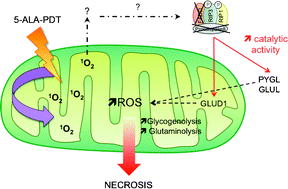Glioblastoma constitute the most frequent and deadliest brain tumors of astrocytic origin. They are resistant to all current therapies and are associated with a high rate of recurrence. Glioblastoma were previously shown to respond to treatments by 5-aminolevulinic acid (5-ALA)-based photodynamic therapy (PDT) mainly by activating a necrotic type of cell death. The receptor-interacting protein 3 (RIP3) has recently been outlined as a key mediator of this caspase-independent form of programmed cell death. In the present study, we analyzed the necrotic mechanism induced by 5-ALA-PDT in human glioblastoma cells and explored the role of RIP3 in this context. Our results show that PDT-induced necrosis is dependent on RIP3, which forms aggregates and colocalizes with RIP1 following photosensitization. We demonstrate that PDT-mediated singlet oxygen production is the cause of RIP3-dependent necrotic pathway activation. We also prove that PDT induces the formation of a pro-necrotic complex containing RIP3 and RIP1 but lacking caspase-8 and FADD, two proteins usually part of the necrosome when TNF-α is used as a stimulus. Thus, we hypothesize that PDT might lead to the formation of a different necrosome whose components, besides RIP1 and RIP3, are still unknown. In most cases, glioblastoma are characterized by a constitutive activation of NF-κB. This factor is a key regulator of various processes, such as inflammation, immune response, cell growth or apoptosis. Its inhibition was shown to further sensitize glioblastoma cells to PDT-induced necrosis, however, no difference in RIP3 upshift or aggregation could be observed when NF-κB was inhibited.

You have access to this article
 Please wait while we load your content...
Something went wrong. Try again?
Please wait while we load your content...
Something went wrong. Try again?


 Please wait while we load your content...
Please wait while we load your content...